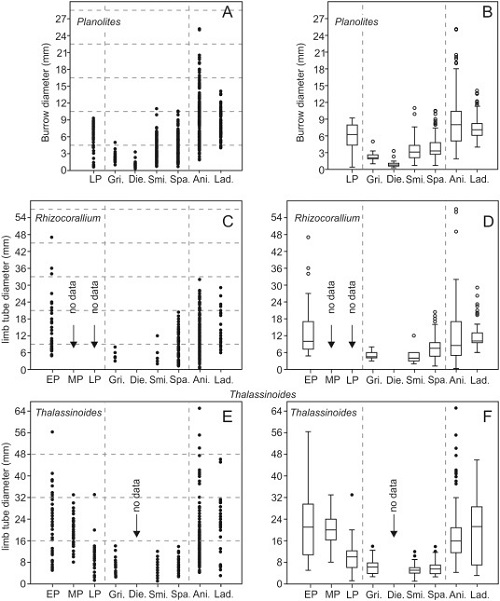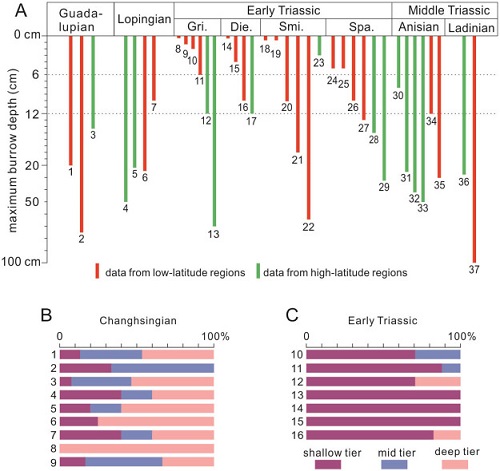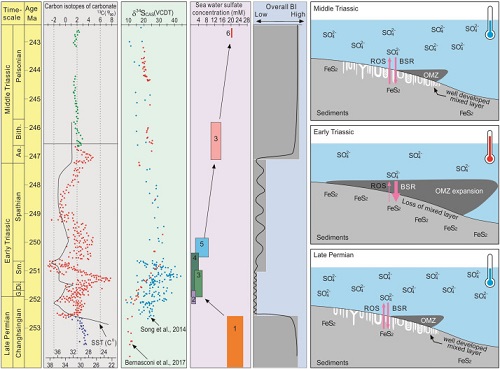Trace fossils, as behavioural records of organisms in the geological past, have been proved useful in deciphering the mechanisms and timing of biotic recovery after mass extinctions. In many cases, trace fossils record the behaviours of soft-bodied organisms that have null to very limited preservation potential in the fossil record. They often provide significant ecologic information on ancient communities not available from the study of body fossils.
More and more ichnologists focused on ichnological records during mass extinctions and subsequent biotic recovery intervals, with numerous studies emphasizing ichnological proxies as indicators of biotic recovery process after the latest Permian, when the the end-Permian mass extinction (EPME) has caused the highest biodiversity loss coupled with the most profound ecological impact in Phanerozoic Earth history.
The vast majority of ichnological studies have focused on elucidating the timing and patterns of ecosystem recovery after the EPME, leading to the establishment of various ichnological parameters (e.g., ichnodiversity, bioturbation indices, bedding plane bioturbation indices, burrow sizes, tiering, trace-fossil complexity) as proxies for unraveling the pacing and processes of biotic recovery in the Early Triassic.
However, some recognitions derived from ichnological studies seem to be inconsistent with those from body fossil observations (prolonged, stepwise recovery versus fast recovery). In addition, there are also cases whereby different ichnologists choose to use different parameters (e.g., ichnofabric indices and bioturbation indices) for documenting the same ichnological features. These discrepancies pose a need to critically evaluate current and popular ichnological parameters and the scopes of their applicability.
Recently, Dr. LUO Mao from Nanjing Institute of Geology and Palaeontology, Chinese Academy of Sciences (NIGPAS) in collaboration with Prof. SHI Guangrong from University of Wollongong (Australia), Prof. Buatois from University of Saskatchewan (Canada), and Prof. CHEN Zhongqiang from China University of Geoscience (Wuhan) presented a critical review on the use of various ichnological parameters as relative proxies for unravelling ecosystem recovery after the EPME in order to place them on more solid theoretical grounds. In their study, the significance and caveats of various ichnological parameters and their limitations are clarified and discussed in detail, in the hope that these proxies will be more appropriately used in the future studies dealing with mass extinctions and biotic recoveries. Related research results has been published online in the comprehensive geology journal Earth-Science Reviews.
According to Dr. LUO Mao, ichnodiversity, ichnodisparity, burrow sizes are good indicators of biotic recovery, while bedding plane bioturbation indices remain to be explored further as various studies suggest that on bedding planes, trace-fossil distribution can be heterogeneous on a scale of meters to decimeters. In terms of tiering, the composition of the different tiers (e.g., shallow, intermediate, and deep tier) should be reconstructed rather than only considering the penetration depth of burrows. Further, it is worth noting that evaluating the benthic ecospace occupation and ecosystem engineering through the analysis of trace fossils would be a promising approach.
Based on current ichnological studies from the Permian-Triassic interval and researchers own observations, Dr. LUO Mao and his collaborators have reached several main recognitions for biotic recovery after the end-Permian mass extinction. These are:
(1) Distribution of varying oxic conditions results in the disparate patterns of benthic macrofaunal recovery (including trace-making organisms) in the Early Triassic. Such oxic conditions in the shallow-marine ‘habitable zone’ possibly aid a faster recovery of trace-making organisms in the earliest Triassic.
(2) The widespread matground-dominated ecosystems could have inhabited a variety of metazoans (including trace makers) during the Earl Triassic recovery interval.
(3) Low bioturbation intensities in the Lower Triassic strata may be a reason leading to enhanced pyrite burial and prolonged low sulfate concentrations in the Early Triassic ocean.
This research has been supported by the Strategic Priority Research Program of the Chinese Academy of Sciences, the CAS Pioneer Hundred Talents Program, and by grants from NSFC.

Trend of ichnodiversity along a depositional profile (modified from Buatois and Mángano, 2013)

Trend of burrow-size changes for typical ichnotaxa (Planolites, Rhizocorallium, Thalassinoides) from Permian to Middle Triassic (global data)

Tiering structure as expressed by the maximum penetration depth and ichnological composition at different sediment depths

Integrated marine geochemical variations and general bioturbation intensity during the Permian-Triassic interval, with geochemical cycling models established for the Late Permian, Early Triassic, and Middle Triassic respectively
Download:
